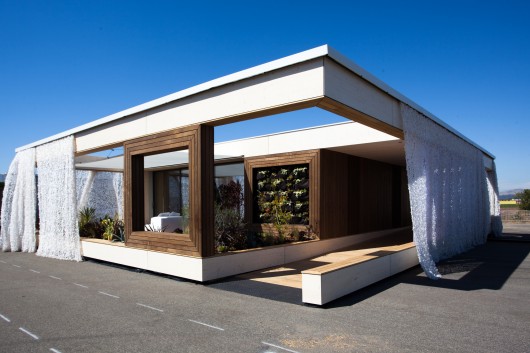© Jason Flakes/U.S. Department of Energy Solar Decathlon
From the architect. A team of Austrian students from Vienna University of Technology (Team Austria) has has won top honors for “designing, building, and operating the most cost-effective, energy-efficient and attractive solar-powered house” at the 2013 U.S. Department of Energy (DOE) Solar Decathlon. The net-positive home, known as “LISI – Living inspired by sustainable innovation,” prides itself for being a simple, smart house that is capable of adapting to a variety of lifestyles and climate zones.
Prior to being crowned as winner, LISI competed against eighteen other student-built, solar-powered homes over the course of ten days in Irvine, California. This was the first time an Austrian university has participated in the U.S. Solar Decathlon. Learn more about the winning design by reading the team’s project description after the break.

Over the course of three semesters an interdisciplinary group of students from the Vienna University of Technology developed a variety of concepts regarding floor plan layout, interior design, as well as facade systems with a primary goal to design a compact, affordable and energy efficient home for different users and sites. The result is LISI, an “energy+ atrium house” for two individuals that is completely powered by self-produced solar energy.


The plus-energy home generates all required energy from a roof-mounted PV array. The supply of cold and hot water for space heating, cooling and for domestic hot water relies on two air-water heat pumps. Comfortable air conditions are provided by an ERV unit, which acts as a heat and humidity exchanger between used exhausted air and fresh intake air. A functional floor system regulates the entire buildings climate using water, air, and active cubic capacity. It efficiently provides heating, cooling, and fresh air to create a consistently comfortable indoor climate. In addition, an innovative shower tray recovers thermal energy from drain water through a heat exchanger, significantly reducing the net energy consumption needed for daily hygiene.
The synergy of modular timber lightweight construction, the use of eco-friendly materials and renewable energies, plus sophisticated home automation creates a sustainable and affordable high-quality housing project adaptable for different needs of users and sites.
University of Nevada Las Vegas took second place, followed by Czech Republic, comprised of students from Czech Technical University, in third place. Stay tuned for more information.
More about LISI can be found on the team’s website here.
From the architect. A team of Austrian students from Vienna University of Technology (Team Austria) has has won top honors for “designing, building, and operating the most cost-effective, energy-efficient and attractive solar-powered house” at the 2013 U.S. Department of Energy (DOE) Solar Decathlon. The net-positive home, known as “LISI – Living inspired by sustainable innovation,” prides itself for being a simple, smart house that is capable of adapting to a variety of lifestyles and climate zones.
Prior to being crowned as winner, LISI competed against eighteen other student-built, solar-powered homes over the course of ten days in Irvine, California. This was the first time an Austrian university has participated in the U.S. Solar Decathlon. Learn more about the winning design by reading the team’s project description after the break.

© LISI – Solar Decathlon Team Austria
Over the course of three semesters an interdisciplinary group of students from the Vienna University of Technology developed a variety of concepts regarding floor plan layout, interior design, as well as facade systems with a primary goal to design a compact, affordable and energy efficient home for different users and sites. The result is LISI, an “energy+ atrium house” for two individuals that is completely powered by self-produced solar energy.

[1] North Patio [2] Living Space [3] South Patio [4] Mechanical Room [5] Bathroom [6] BedroomDue to the delivery of the building in several standard shipping containers, LISI is designed as a pre-fabricated modular wooden frame construction that allows quick and simple assembly and disassembly.

© LISI – Solar Decathlon Team Austria

© LISI – Solar Decathlon Team Austria

© LISI – Solar Decathlon Team Austria
This simple plan consists of three zones: service core, living area and adjacent patios, which may be enclosed using a flexible facade. A ramp, enveloped by a textile facade, leads users first onto the northern patio and then into a 60 square meter central living area which can be extended by the north and south patios by fully opening the large-scaled glass sliding elements. Inside and directly east of the living space is the service core, housing a bathroom, bedroom and all the essential technical equipment to control the smart home. Depending on the climatic or social needs of the residents different textile shading elements help LISI to close or open up to the surrounding area.

© Jason Flakes/U.S. Department of Energy Solar Decathlon
The plus-energy home generates all required energy from a roof-mounted PV array. The supply of cold and hot water for space heating, cooling and for domestic hot water relies on two air-water heat pumps. Comfortable air conditions are provided by an ERV unit, which acts as a heat and humidity exchanger between used exhausted air and fresh intake air. A functional floor system regulates the entire buildings climate using water, air, and active cubic capacity. It efficiently provides heating, cooling, and fresh air to create a consistently comfortable indoor climate. In addition, an innovative shower tray recovers thermal energy from drain water through a heat exchanger, significantly reducing the net energy consumption needed for daily hygiene.
The synergy of modular timber lightweight construction, the use of eco-friendly materials and renewable energies, plus sophisticated home automation creates a sustainable and affordable high-quality housing project adaptable for different needs of users and sites.
University of Nevada Las Vegas took second place, followed by Czech Republic, comprised of students from Czech Technical University, in third place. Stay tuned for more information.
More about LISI can be found on the team’s website here.


Δεν υπάρχουν σχόλια:
Δημοσίευση σχολίου